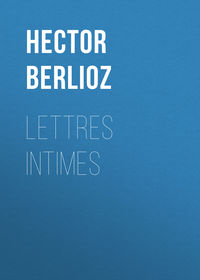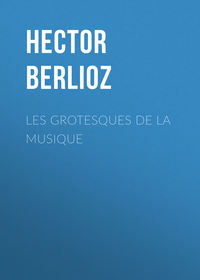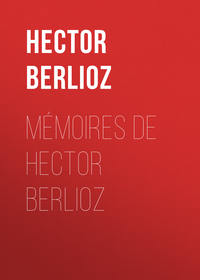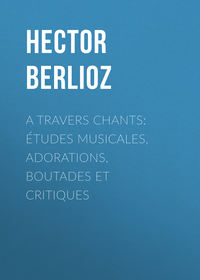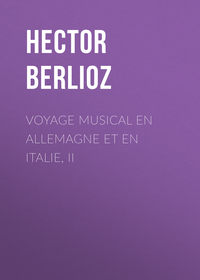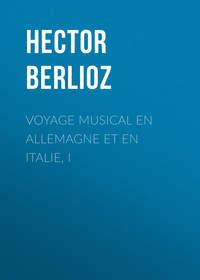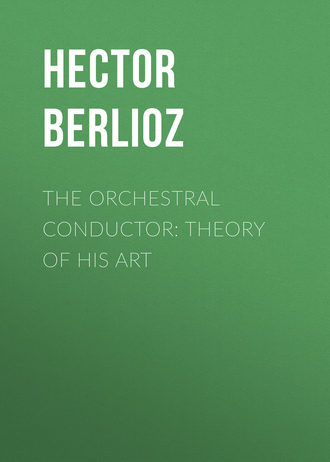 полная версия
полная версияThe Orchestral Conductor: Theory of His Art

Hector Berlioz
The Orchestral Conductor: Theory of His Art
THE ORCHESTRAL CONDUCTOR.
THEORY OF HIS ART
Music appears to be the most exacting of all the Arts, the cultivation of which presents the greatest difficulties, for a consummate interpretation of a musical work so as to permit an appreciation of its real value, a clear view of its physiognomy, or discernment of its real meaning and true character, is only achieved in relatively few cases. Of creative artists, the composer is almost the only one who is dependent upon a multitude of intermediate agents between the public and himself; intermediate agents, either intelligent or stupid, devoted or hostile, active or inert, capable – from first to last – of contributing to the brilliancy of his work, or of disfiguring it, misrepresenting it, and even destroying it completely.
Singers have often been accused of forming the most dangerous of these intermediate agents; but in my opinion, without justice. The most formidable, to my thinking, is the conductor of the orchestra. A bad singer can spoil only his own part; while an incapable or malevolent conductor ruins all. Happy indeed may the composer esteem himself when the conductor into whose hands he has fallen is not at once incapable and inimical; for nothing can resist the pernicious influence of this person. The most admirable orchestra is then paralyzed, the most excellent singers are perplexed and rendered dull; there is no longer any vigor or unity; under such direction the noblest daring of the author appears extravagant, enthusiasm beholds its soaring flight checked, inspiration is violently brought down to earth, the angel's wings are broken, the man of genius passes for a madman or an idiot, the divine statue is precipitated from its pedestal, and dragged in the mud. And what is worse, the public, and even auditors endowed with the highest musical intelligence, are reduced to the impossibility (if a new work is rendered, and they are hearing it for the first time) of recognizing the ravages perpetrated by the orchestral conductor – of discovering the follies, faults, and crimes he commits. If they clearly perceive certain defects of execution, not he, but his victims, are in such cases made responsible. If he has caused the chorus-singers to fail in taking up a point in a finale, if he has allowed a discordant wavering to take place between the choir and the orchestra, or between the extreme sides of the instrumental body, if he has absurdly hurried a movement, or allowed it to linger unduly, if he has interrupted a singer before the end of a phrase, they exclaim: “The singers are detestable! The orchestra has no firmness; the violins have disfigured the principal design; everybody has been wanting in vigor and animation; the tenor was quite out, he did not know his part; the harmony is confused; the author is no accompanist; the voices are – ” etc.
Except in listening to great works already known and esteemed, intelligent hearers can hardly distinguish the true culprit, and allot to him his due share of blame; but the number of these is still so limited that their judgment has little weight; and the hostile conductor – in presence of the public who would pitilessly hiss a vocal accident of a good singer – reigns, with all the calm of a bad conscience, in his baseness and inefficiency. Fortunately, I here attack an exception; for the malevolent orchestral conductor – whether capable or not – is very rare.
The orchestral conductor full of goodwill, but incapable, is on the contrary very common. Without speaking of innumerable mediocrities, directing artists who frequently are much their superiors, an author for example, can scarcely be accused of conspiring against his own works. Yet how many are there who, fancying they are able to conduct, innocently injure their best scores!
Beethoven, it is said, more than once ruined the performance of his symphonies; which he would conduct, even at the time when his deafness had become almost complete. The musicians, in order to keep together, agreed at length to follow the slight indications of time which the concertmeister (first violin-player) gave them; and not to attend to Beethoven's conducting-stick. Moreover, it should be observed, that conducting a symphony, an overture, or any other composition whose movements remain continual, vary little, and contain few nice gradations, is child's play in comparison with conducting an opera, or like work, where there are recitatives, airs, and numerous orchestral designs preceded by pauses of irregular length.
The example of Beethoven, which I have just cited, leads me at once to say that if the direction of an orchestra appears to be very difficult for a blind man, it is indisputably impossible for a deaf one, whatever may have been his technical talent before losing his sense of hearing.
The orchestral conductor should see and hear; he should be active and vigorous, should know the composition and the nature and compass of the instruments, should be able to read the score, and possess – besides the especial talent of which we shall presently endeavor to explain the constituent qualities – other indefinable gifts, without which an invisible link cannot establish itself between him and those he directs; otherwise the faculty of transmitting to them his feeling is denied him, and power, empire, and guiding influence completely fail him. He is then no longer a conductor, a director, but a simple beater of the time, – supposing he knows how to beat it, and divide it, regularly.
The performers should feel that he feels, comprehends, and is moved; then his emotion communicates itself to those whom he directs, his inward fire warms them, his electric glow animates them, his force of impulse excites them; he throws around him the vital irradiations of musical art. If he is inert and frozen, on the contrary, he paralyzes all about him, like those floating masses of the polar seas, the approach of which is perceived through the sudden cooling of the atmosphere.
His task is a complicated one. He has not only to conduct, in the spirit of the author's intentions, a work with which the performers have already become acquainted, but he must also introduce new compositions and help the performers to master them. He has to criticise the errors and defects of each during the rehearsals, and to organize the resources at his disposal in such a way as to make the best use he can of them with the utmost promptitude; for, in the majority of European cities nowadays, musical artisanship is so ill distributed, performers so ill paid and the necessity of study so little understood, that economy of time should be reckoned among the most imperative requisites of the orchestral conductor's art.
Let us now see what constitutes the mechanical part of this art.
The power of beating the time, without demanding very high musical attainments, is nevertheless sufficiently difficult to secure; and very few persons really possess it. The signs that the conductor should make – although generally very simple – nevertheless become complicated under certain circumstances, by the division and even the subdivision of the time of the bar.
The conductor is, above all, bound to possess a clear idea of the principal points and character of the work of which he is about to superintend the performance or study; in order that he may, without hesitation or mistake, at once determine the time of each movement desired by the composer. If he has not had the opportunity of receiving his instructions directly from the composer, or if the times have not been transmitted to him by tradition, he must have recourse to the indications of the metronome, and study them well; the majority of composers, nowadays, taking the precaution to write them at the beginning, and in the course, of their pieces. I do not mean to say by this that it is necessary to imitate the mathematical regularity of the metronome, all music so performed would become of freezing stiffness, and I even doubt whether it would be possible to observe so flat a uniformity during a certain number of bars. But the metronome is none the less excellent to consult in order to know the original time, and its chief alterations.
If the conductor possess neither the author's instructions, tradition, nor metronome indications, – which frequently happens in the ancient masterpieces, written at a period when the metronome was not invented, – he has no other guide than the vague terms employed to designate the time to be taken, and his own instinct, his feeling – more or less distinguishing, more or less just – of the author's style. We are compelled to admit that these guides are too often insufficient and delusive. Of this we have proof in seeing how old operas are given in towns where the traditional mode of performance no longer exists. In ten different kinds of time, there will always be at least four taken wrongly. I once heard a chorus of Iphigenia in Tauride performed in a German theatre allegro assai, two in the bar, instead of allegro non troppo, four in the bar; that is to say, exactly twice too fast. Examples might be multiplied of such disasters, occasioned either by the ignorance or the carelessness of conductors of orchestras; or else by the real difficulty which exists for even the best-gifted and most careful men to discover the precise meaning of the Italian terms used as indications of the time to be taken. Of course, no one can be at a loss to distinguish a Largo from a Presto. If the Presto be two in a bar, a tolerably sagacious conductor, from inspection of the passages and melodic designs contained in the piece, will be able to discern the degree of quickness intended by the author. But if the Largo be four in a bar, of simple melodic structure, and containing but few notes in each bar, what means has the hapless conductor of discovering the true time? And in how many ways might he not be deceived? The different degrees of slowness that might be assigned to the performance of such a Largo are very numerous; the individual feeling of the orchestral conductor must then become the sole authority; and, after all, it is the author's feeling, not his, which is in question. Composers therefore ought not to neglect placing metronome indications in their works; and orchestral conductors are bound to study them closely. The neglect of this study on the part of the latter, is an act of dishonesty.
I will now suppose the conductor to be perfectly well acquainted with the times of the different movements in the work of which he is about to conduct the performance or rehearsals; he wishes to impart to the musicians acting under his orders the rhythmical feeling within him, to decide the duration of each bar, and to cause the uniform observance of this duration by all the performers. Now this precision and this uniformity can only be established in the more or less numerous assemblage of band and chorus by means of certain signs made by their conductor.
These signs indicate the principle divisions, the accents of the bar, and, in many cases, the subdivisions, and the half-accents. I need hardly here explain what is meant by the “accents” (accented and unaccented parts of a bar); I am presupposing that I address musicians.
The orchestral conductor generally uses a small light stick, of about a foot in length, and rather whitish than of a dark color (it is seen better), which he holds in his right hand, to make clearly distinct his mode of marking the commencement, the interior division, and the close of each bar. The bow, employed by some violinist conductors (leaders), is less suitable than the stick. It is somewhat flexible, and this want of rigidity, together with the slight resistance it offers to the air, on account of its appendage of hair, renders its indications less precise.
The simplest of all times – two in a bar – is beaten simply.
The arm and the stick of the conductor are raised, so that his hand is on a level with his head, he marks the first beat, by dropping the point of his stick perpendicularly (bending his wrist as much as possible; and not lowering the whole arm), and the second beat by raising the stick by a contrary gesture.

The time – one in a bar – being in reality, and particularly for the conductor, but the time of an extremely rapid two in a bar, should be beaten like the preceding. As the conductor is obliged to raise the point of his stick, after having lowered it, he necessarily divides this into two portions.

In the time – four in a bar – the first gesture, or down beat, is universally adopted for marking the first accented part, the commencement of the bar.
The second movement made by the conducting-stick, from right to left, rising, indicates the second beat (first unaccented part).


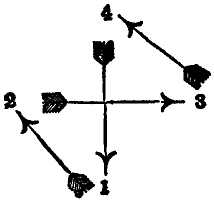
It is of importance that the conductor, in thus delivering his different directions, should not move his arm much; and consequently, not allow his stick to pass over much space; for each of these gestures should operate nearly instantaneously; or at least, take but so slight a movement as to be imperceptible. If the movement becomes perceptible, on the contrary, and multiplied by the number of times that the gesture is repeated, it ends by throwing the conductor behind in the time he is beating, and by giving to his conducting a tardiness that proves injurious. This defect, moreover, has the result of needlessly fatiguing the conductor, and of producing exaggerated evolutions, verging on the ridiculous, which attract the spectators' attention, and become very disagreeable to witness.
In the time, three in a bar, the first gesture made, from up to down, is likewise universally adopted for marking the first beat; but there are two ways of marking the second. The majority of orchestral conductors indicate it by a gesture from left to right; thus: —
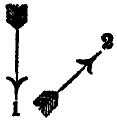
Some German Kapel-meisters do the contrary; and carry the stick from right to left; thus: —
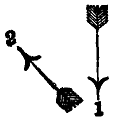
This way has the disadvantage – when the conductor turns his back to the orchestra, as in theatres – of permitting only a small number of musicians to perceive the very important indication of the second beat; the body of the conductor then hiding the movement of his arm. The other method of proceeding is preferable; since the conductor stretches his arm outwards, withdrawing it from his chest; and his stick, which he takes care to raise slightly above the level of his shoulder, remains perfectly visible to all eyes. When the conductor faces the players, it is immaterial whether he marks the second beat to the right, or to the left.

However, the third beat of the time, three in a bar, is always marked like the last of the time, four in a bar; by an oblique movement upwards.
The times, – five and seven in a bar, – would be more comprehensible for the performers, if instead of indicating them by a particular series of gestures, they were treated as though the one was composed of three and two in a bar, and the other composed of four and three.
Then, these times would be beaten thus: —
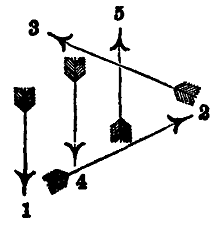
Example of seven in a bar: —
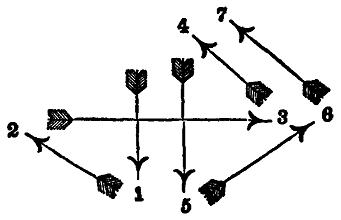
These different times, in order to be divided in this way, are assumed to belong to movements of moderate measure. The advice would not hold good if their measure were either very quick or very slow.
The time, two in a bar, I have already signified, cannot be beaten otherwise than as we have before seen – whatever its degree of rapidity. But if, as an exception, it should be very slow, the conductor ought to subdivide it.
A very rapid four in a bar, on the contrary, should be beaten two in a bar; the four accustomed gestures of a moderate movement becoming then so hurried as to present nothing decided to the eye, and serving only to confuse the performer instead of giving him confidence. Moreover, – and this is of much more consequence, – the conductor, by uselessly making these four gestures in a quick movement, renders the pace of the rhythm awkward, and loses the freedom of gesture which a simple division of the time into its half would leave him.
Generally speaking, composers are wrong to write in such a case the indication of the time as four in a bar. When the movement is very brisk, they should never write any other than the sign


It is exactly the same for the time, three in a bar, fast 3⁄4 or 3⁄8. Then the conductor must omit the gesture of the second beat, and, by remaining the period of a beat longer on the first, only raise the stick at the third.

It would be absurd to attempt to beat the three in a bar of one of Beethoven's scherzos.
In slow movements the rule for these two times is like that for two in a bar. If the movement is very slow, each time must be divided; and consequently eight gestures must be made for the time, four in a bar, and six for the time, three in a bar, repeating (and shortening) each of the principal gestures we have before instanced.
Example of three in a bar, very slow:
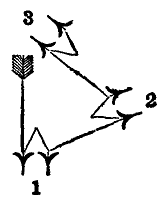
Example of four in a bar, very slow:
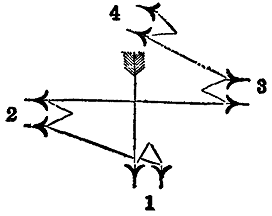
The arm should take no part in the little supplementary gesture indicating the subdivision of the bar; merely the wrist causing the stick to move.
This division of the different times is intended to prevent the rhythmical divergences which might easily take place among the performers during the interval which separates one beat from the other. The conductor not indicating anything during this period (rendered somewhat considerable by the extreme slowness of the movement), the players are then entirely left to themselves, without conductor; and as the rhythmical feeling is not the same with all, it follows that some hurry, while others slacken, and unity is soon destroyed. The only exception possible to this rule is that of a first-rate orchestra, composed of performers who are well acquainted with each other, are accustomed to play together, and know almost by heart the work they are executing. Even then, the inattention of a single player may occasion an accident. Why incur its possibility? I know that certain artists feel their self-love hurt when thus kept in leading-strings (like children, they say); but with a conductor who has no other view than the excellence of the ultimate result, this consideration can have no weight. Even in a quartet, it is seldom that the individual feeling of the players can be left entirely free to follow its own dictates. In a symphony, that of the conductor must rule. The art of comprehending it, and fulfilling it with unanimity, constitutes the perfection of execution; and individual wills – which can never agree one with another – should never be permitted to manifest themselves.
This being fully understood, it will be seen that subdivision is still more essential for very slow times; as those of 6⁄4, 6⁄8, 9⁄8, 12⁄8 etc.
But these times – where the triple rhythm plays so important a part – may be divided in various ways.
If the movement is brisk or moderate, it is rarely well to indicate other than the simple beats of these times, according to the procedure adopted for the analogous simple times.
The times of 6⁄8 allegretto, and of 6⁄4 allegro, therefore, are to be beaten like those of two in a bar: —


It is unnecessary, in this three in a bar, to mark all the quavers; the rhythm of a crotchet followed by a quaver in each beat suffices.
As to the subdivision, the little supplementary gesture for simple times should be made; this subdivision will however separate each beat into two unequal portions, since it is requisite to indicate visibly the value of the crotchet, and that of the quaver.
If the movement is still slower, there can be no hesitation; the only way to ensure unity of execution is to beat all the quavers, whatever be the nature of the written bar.



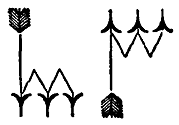
Taking the three measures shown above in order, the conductor must beat three quavers down, and three up, for the time of 6⁄8: —
Three down, three to the right, and three up, for the time of 9⁄8: —

Three down, three to the left, three to the right, and three up, for the time of 12⁄8: —
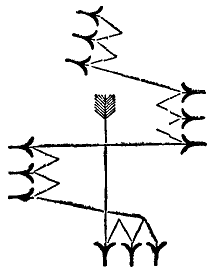
A dilemma sometimes presents itself when certain parts – for the sake of contrast – are given a triple rhythm, while others preserve the dual rhythm.

If the wind-instrument parts in the above example are confided to players who are good musicians, there will be no need to change the manner of marking the bar, and the conductor may continue to subdivide it by six, or to divide it simply by two. The majority of players, however, seeming to hesitate at the moment when, by employing the syncopated form, the triple rhythm clashes with the dual rhythm, require assurance, which can be given by easy means. The uncertainty occasioned them by the sudden appearance of the unexpected rhythm, contradicted by the rest of the orchestra, always leads the performers to cast an instinctive glance towards the conductor, as if seeking his assistance. He should look at them, turning somewhat towards them, and marking the triple rhythm by very slight gestures, as if the time were really three in a bar, but in such a way that the violins and other instruments playing in dual rhythm may not observe the change, which would quite put them out. From this compromise it results that the new rhythm of three-time, being marked furtively by the conductor, is executed with steadiness; while the two-time rhythm, already firmly established, continues without difficulty, although no longer indicated by the conductor. On the other hand, nothing, in my opinion can be more blamable, or more contrary to musical good sense, than the application of this procedure to passages where two rhythms of opposite nature do not co-exist, and where merely syncopations are introduced. The conductor, dividing the bar by the number of accents he finds contained in it, then destroys (for all the auditors who see him) the effect of syncopation; and substitutes a mere change of time for a play of rhythm of the most bewitching interest. If the accents are marked, instead of the beats, in the following passage from Beethoven's Pastoral Symphony, we have the subjoined: —


